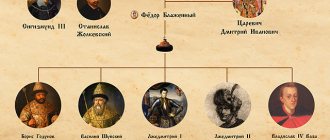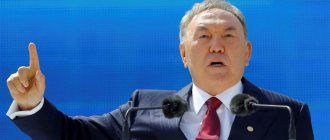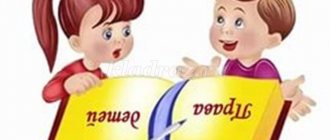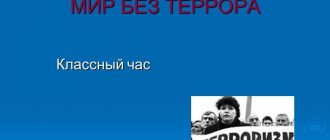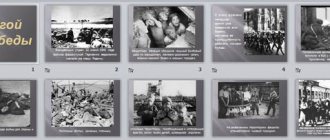Class hour National Unity Day.
1. Opening remarks.Presenter 1
. Before we start the lesson. Let's find out what holiday our whole country celebrates in November? (November 4 is National Unity Day)
So, the topic of our lesson is “National Unity Day.” Today we will talk about a new Russian holiday, its origins and meaning.
The lesson will be guided by the words of Patriarch Alexy of Moscow and All Rus'.
“Russia is strong only when it is united!»
Questions:
— Maybe some of you know what this holiday symbolizes?
— Why was there a need to revive this holiday?
— What events became the basis of national unity, and who was at the head of national unity?
(Students express their assumptions about the holiday)
Today, some of you will learn something new for yourself, others will remember what they knew before.
Our lesson dedicated to National Unity Day.
Presenter 2
: National Unity Day is one of the youngest holidays in our country. On December 16, 2004, Russian President V.V. Putin signed the Federal Law “On the Amendment to Article 1 of the Federal Law “On the Days of Military Glory (Victory Days) of Russia,” in which November 4 was declared National Unity Day. The immediate reason for the introduction of the new holiday was the planned cancellation of the celebration of November 7, which in people's minds is associated with the anniversary of the October Revolution of 1917.
This holiday of the unity of Russia was established in memory of the events of November 4, 1612, Russians of different faiths and nationalities overcame division, overcame a formidable enemy and led the country to a stable civil peace.
On November 4, we honor the memory of the military feat of our ancestors, who saved the Russian state from destruction in 1612 and demonstrated an example of heroism and cohesion, regardless of origin, religion and position in society. This was the case during the war with Napoleon, in the battles with the Nazi invaders. The sons of the fatherland have repeatedly shown examples of self-sacrifice for the sake of their Motherland.
We must not forget the simple truth: we are strong when we are united. Only by becoming a united people can the freedom and power of the state be preserved.
1) History of the holiday.
Presenter 1.
Throughout history, Russia has been tested many times for its strength; more than once it has experienced times when unity was disrupted, when disintegration, chaos, hostility, anarchy, and disaster reigned in the country. Troubled times often shook Russia to its very foundations. But the country rose from the ashes again and again. After each tragedy, she only became stronger, the envy of her enemies.
2) Time of Troubles
Presenter 1.
The years 1610–1613 were years of interregnum, hard times, and unrest. Pestilence, famine, bloody civil strife, and enemy invasions devastated the country to the ground. The Russian people called the time of troubles. This is the most difficult period in Russian history after the Mongol-Tatar yoke. The country was left without a king and without a royal dynasty that united the people into a state, a power.
Presenter 2.
Today we will remember those who, in difficult times for the country, showed selfless love for the Fatherland, the greatest valor and heroism, the ability to withstand the most difficult trials and defend their independence.
3) National heroes.
Kuzma Minina and Dimitry Pozharsky . Presenter 2.
It so happened that the troops of the Polish gentry ruled on Russian soil. The Swedish invaders did not lag behind them. They captured Novgorod and the cities and villages closest to it. English businessmen were preparing to seize the northern part of Russia. The smoke of the fires spread across the Russian soil, the abandoned fields were overgrown with weeds. To escape the violence, peasants fled into the forests. The very existence of independent Russia was under threat.
And yet, there were healthy forces - both among the common people and among the ruling elite. We remember their leaders - Kuzma Minin and Prince Dimitry Pozharsky, they united to save the country. In 1611, in Nizhny Novgorod, the zemstvo elder Kuzma Minin made an appeal to give up the last for the sake of saving the country, and convened a people's militia.
On November 4, 1612, militias led by Kuzma Minin and Dimitry Pozharsky took Kitay-Gorod by storm, and the Polish garrison retreated to the Kremlin. Prince Pozharsky entered Kitai-Gorod with the Kazan Icon of the Mother of God and vowed to build a temple in memory of this victory.
The entire Russian land stood up against the invaders and traitors. The battles for Moscow began. Prince Pozharsky turned out to be a talented commander. And Kozma Minin, not sparing his life, fought under the walls of the capital like a simple warrior.
Pozharsky besieged Moscow for two months. Soon the Poles surrendered, Pozharsky triumphantly entered the city.
November 4 (October 22, old style) 1612
the enemy army surrendered to the mercy of the victors.
When times of peace came, the new tsar generously rewarded Minin and Pozharsky. Peter 1 called Kuzma Minin “the savior of the Fatherland.” But the best reward was people's memory. On February 20, 1818, in Moscow on Red Square, a monument to the heroes of the Time of Troubles - Kuzma Minin and Dmitry Pozharsky - was unveiled in a solemn ceremony.
Here are portraits of real heroes. They managed to unite the people around the idea of serving the Fatherland. They started talking about brotherly love and sacrifice. And they did the impossible, they defeated the enemy who had overrun the country.
Ivan Susanin.
Presenter 1.
Truly, Ivan Osipovich Susanin became the national hero of that harsh time. At the beginning of 1613, when Moscow had already been liberated from Polish invaders, troops of invaders were still roaming Russian soil in the hope of changing the outcome of the war. One of these detachments wanted to capture the newly elected Russian Tsar Mikhail Fedorovich Romanov, who lived near Kostroma. It was then that a peasant from the village of Domnino, located near Kostroma, Ivan Osipovich Susanin, accomplished his famous feat. The enemies tried to make him their guide, but he led the invaders into a deep forest, killed them, but died himself. Proof of the reality of Ivan Osipovich Susanin’s feat is the royal charter granting Bogdan Sabinin (Susanin’s son-in-law) half of the village for the feat of his late father-in-law.
In 1851, a monument to the peasant Ivan Susanin was erected in Kostroma in honor of the legendary feat during the Time of Troubles. Works of musical, visual and verbal art are dedicated to Ivan Susanin and his feat: the opera by M. I. Glinka “Ivan Susanin” (“Life for the Tsar”), the opera by K. A. Kavos (“Ivan Susanin”), the duma by K. F. Ryleev “Ivan Susanin”, drama by N. A. Polevoy “Kostroma Forests”, painting by M. I. Scotti “The Feat of Ivan Susanin”.
Presenter 2.
The attempt of the interventionists to take advantage of the difficult situation of Russia and bring it to its knees was stopped by the power of Russian weapons, permeated with the spirit of unity, faith and sincere love for the Motherland.
Therefore, the liberation of the Russian capital on November 4, 1612 became a symbol not only of military glory, but also of the spiritual unity of our people.
Presenter 2.
We celebrate November 4 as the day of preservation and salvation not only of the Russian state, but also of the Russian people, who simply would not have existed if the Time of Troubles had not been overcome.
This is, in fact, the Feast of the Salvation of our Country! Not only from Polish intervention, but also from internal decay. For us, November 4th is a holiday of the unification of society, mutual understanding and respect for our history, for the people who create it, and a reminder that only in unity is our strength and the guarantee of Russia’s prosperity, its greatness and power.
4) Russia today.
Presenter2.
Today's Russia is far from prosperity and prosperity. After all, we also lived through the Time of Troubles, modern Russia was also on the verge of collapse and chaos, but survived, because “Russia is great, but its strength is in unity.”
Let's remember the difficult periods of hard times for the country, when unity was disrupted.
Armenia.
In 1988 there was an earthquake in Armenia. This disaster claimed thousands of lives. Volunteer rescuers who came from all the republics of the then Soviet Union and from many countries of the world worked heroically on the ruins of cities and villages, day and night.
The victims were received in all corners of the USSR as if they were family. People sent money, things, medicine.
2.Chernobyl
April 26, 1986 - this date has gone down in history forever. On this day, the largest accident occurred at the Chernobyl nuclear power plant.
3. Krymsk
July 6, 2012 - a terrible tragedy struck the cities and towns of the Krasnodar Territory - a flood. The city of Krymsk suffered the most.
4. Far East
September 2013 - large-scale flooding in the Far East. Khabarovsk and Primorsky Krai, Amur and Magadan regions, the Republic of Sakha and the Jewish Autonomous Region are drowning. The water rose highest in populated areas on the banks of the Amur.
Student. 9
5.North Ossetia
The seizure of Beslan school No. 1 is a terrorist act committed in Beslan on September 1, 2004. Suicide bombers held more than a thousand people hostage for almost three days. Where innocent children and adults died. The goal of terrorists is to divide the people, intimidate, sow hostility, confusion, and disrupt unity.
6.Ukraine
The whole world followed the events that took place in Ukraine. We do not assess the political situation, but none of us remained indifferent to the misfortune of the Ukrainian people. In the village of Borisovka, as in other settlements in Russia, there was a collection of humanitarian aid. We met refugees, and to this day we help them as best we can.
7. Syria.
And now there is a war in Syria.
The civil war in Syria has been going on for almost four years. It claimed the lives of more than 220,000 people.
Presenter 1.
But there are events in the history of any state, the assessment of which is beyond doubt, has not changed for centuries and will never change.
But in our history there are many bright and glorious pages, but alas, no less dark and sorrowful. But I want to believe that our Fatherland has a happy future ahead. After all, it has happened more than once in Russian history when the difficult years of troubles and adversity were left behind, and life slowly got better and returned to its groove. But even today, people passionately love their Motherland and are ready to stand up for it. You also remember: we need to stick together, help each other, be tolerant, tolerant, respect other people’s interests, be able to forgive, forget grievances.
5) Quiz.
Presenter 1.
Now, guys, let's check how you learned the information received during the class hour, during the quiz. After voicing the question, you raise your hands. Please answer quickly and loudly.
Quiz "On the paths of history."
What historical event occurred on November 4 (October 22, old style) 1612? (The militia led by Minin and Pozharsky took Kitay-Gorod, freeing Moscow from Polish invaders)
In what year and where was the first monument to Minin and Pozharsky erected?
(A monument to Minin and Pozharsky was erected on Red Square in Moscow in 1818.)
What pages of history testify to the unity of peoples?
(Battle of Poltava, the war with Napoleon, WWII, natural disasters...)
Since what year did National Unity Day become a national holiday?
(On December 16, 2004, the State Duma of the Russian Federation adopted simultaneously in three readings amendments to the federal law “On Days of Military Glory”, one of which was the introduction of a new holiday - National Unity Day - November 4.)
6. What was the name of the national hero of that time? (Ivan Susanin)
7. What is the name of the national holiday that we celebrate on November 4? (National Unity Day).
Presenter 2.
Now let's summarize our lesson.
1. Summing up.
What does this holiday call us to?
The new holiday is intended to remind us that we Russians, belonging to different social groups, nationalities and religions, are one people with a common historical destiny and a common future.
What is the essence of National Unity Day?
Day of National Unity, imbued with the ideas of national harmony, social unity, strengthening of Russian statehood, mutual understanding, mercy, and care for people. National Unity Day is a testament to the unity of people and service to society.
Why do we need unity?
In order to build Russia together. When we have trust in each other, when our friendship is strong, we will be able to protect our Motherland from any danger.
What other names does this holiday have?
Day of military glory of Russia. Day of good deeds. On this day we provide assistance to the unfortunate and needy, that is, we engage in charity.
Reflection.
3.Final word.
Dear friends! Our information and educational hour dedicated to National Unity Day has come to an end. I sincerely thank you for your participation in organizing the class hour; I sincerely and sincerely wish you good health, happiness, joy, and the best success in your work and service.
And finally I would like to say,
That the Motherland is like a second mother.
She is not chosen and destroyed,
But they simply protect and love.
Guys, always be interested in what is happening in our country, do not be indifferent to its history. In a word, be worthy of your glorious ancestors. “When we are united, we are invincible!”
